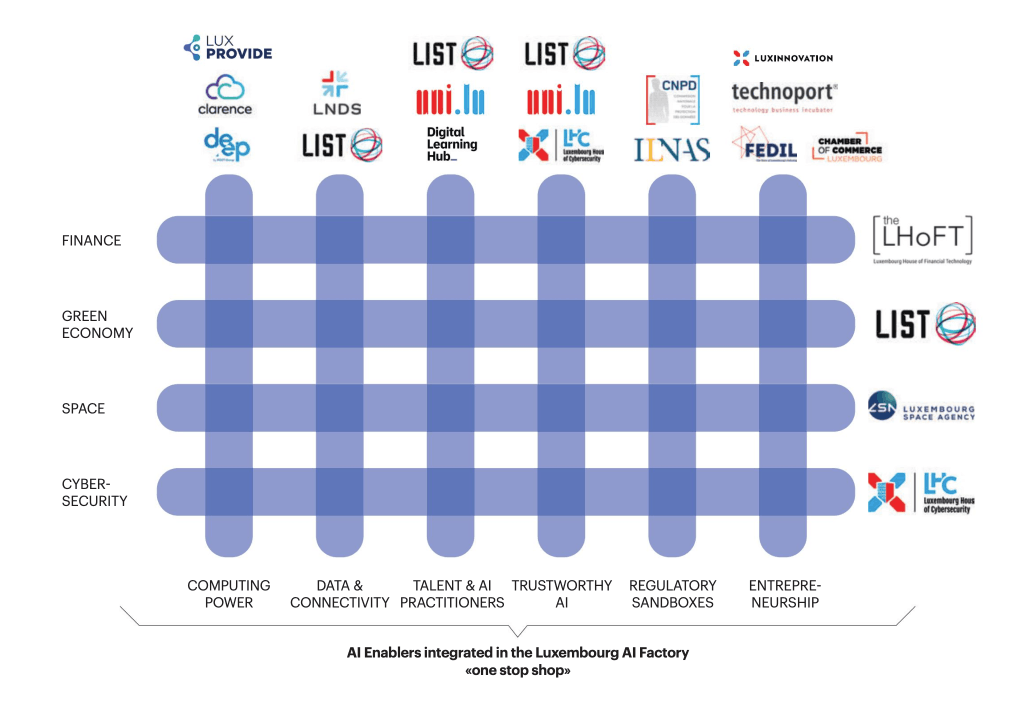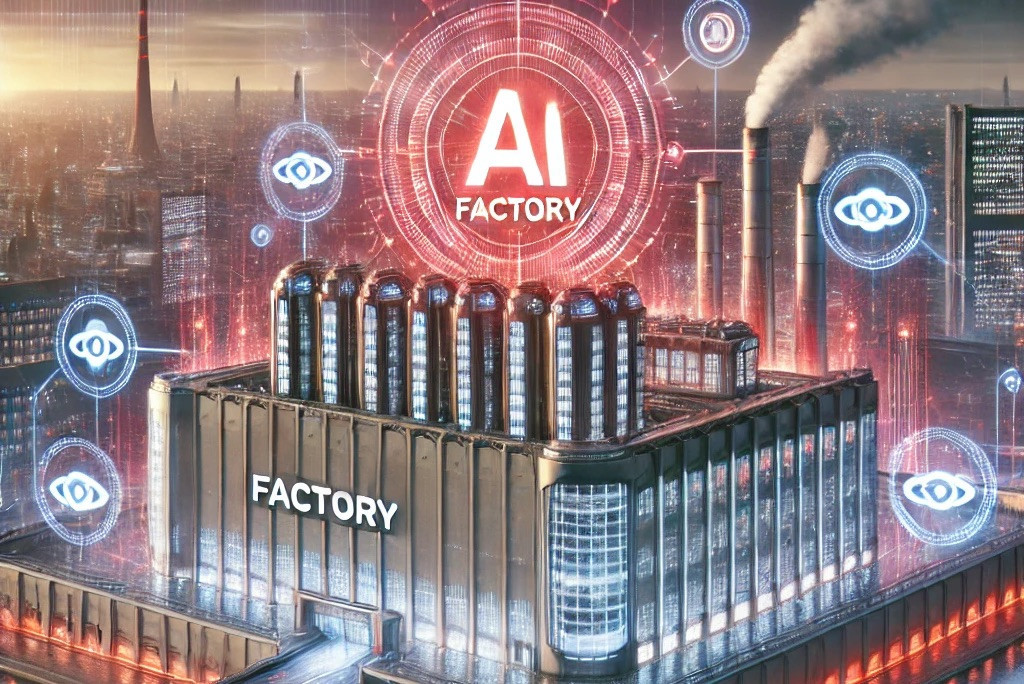Old-timers remember the bus pick-up, the overalls, the time clocks, the smell of fire and steel, the friendships that ended in nearby bars after a paycheck spent in a few hours. Fifty years on, the yellowed photos have not aged well. The factory of the future takes shape in a studious, aseptic atmosphere, where the only heat is given off by a supercomputer that ingests, digests and swallows value-added data.
No need to don a lab coat, protective cap or disposable shoes: Luxprovide CEO sat in a small room, TV screen turned on to the “one-stop-shop” announced a few days earlier by economy minister (DP) and research and higher education minister (DP).
A seven-step customer journey
Lambert’s right index finger points to the box on the left of the screen and traces a customer journey to the right, where the power of the supercomputer specifically designed for artificial intelligence should enable any type of business to move into the future. Seven boxes. A journey that any company wondering about or planning to integrate artificial intelligence into its activities, to manage customers, stocks or HR, can embark on with an expert from the AI Factory.
Step by step, the expert will offer training, then an “assessment,” then put the company representative in touch with the galaxy of solution providers who have already joined the factory of the future. “One of the eight experts made available by Luxinnovation will be able to suggest the best supplier based on the company’s precise needs,” explains Lambert. “Not everyone has the same needs.”
Luxinnovation in January and coordinate the whole thing from the public innovation agency’s side. The next stage involves helping companies to take advantage of funding opportunities--at national or European level--before moving on to the ultimate two-part phase: use of the supercomputer with data injection and implementation of a proof-of-concept or sandboxing and, if all goes to plan, the actual production launch of what has the potential to change the life of any company. There are those who will have given up after the training, those who will have given up after the assessment or for lack of funding. There are those who will have to review their model in the light of the results of the proof-of-concept. A hundred times over, you’ll try and try again…

Priorities and key topics. Source: Luxinnovation
Defence excluded, health left out
Lagging behind the Americans and the Chinese, Europeans have imagined connected and complementary factories of the future all over Europe in order to avoid both a scattering of activities with no added value and deadly duplication. Time is running out.
European funding for these AI Factories guarantees both a sufficient financial envelope and that member states will share common European--as opposed to “national”--ambitions. For its L-AIF, Luxembourg has chosen finance and insurance, cybersecurity, space--where no one else in Europe will be in the same niche--and the green economy (energy transition and sustainable mobility). “But that doesn’t mean that companies with projects in other niches can’t call us,” explains Lambert. “It just means that companies with AI projects in these four areas will be given priority. For the others, we will be able to welcome them but also refer them to the other AI Factories in Europe that have the skills and ecosystem that may suit them.”
And conversely, the 12 other AI Factories that have been made official for the time being--seven in December, including the Luxembourg one at Paperjam’s Top100 event, and a further six in mid-March--will be expected to refer to Luxembourg those projects that stand a better chance in the local ecosystem, with the caveat that the others are rather exclusively interested in research and not businesses.
People in Luxembourg have identified an unspoken opportunity. Luxinnovation’s expertise in accessing European funding, Clarence’s unique sovereign cloud model, Luxconnect or Deep’s data centres and Luxprovide’s certifications have all been identified as reassuring in terms of the cybersecurity of data and models. The ecosystem is brought together at several levels: from the governance of the consortium and the supercomputer for Luxprovide and for the ecosystem to Luxinnovation; the consortium members (the first two plus the Luxembourg National Data Service, the Luxembourg Institute of Science and Technology and the University of Luxembourg); and the associated partners (the Luxembourg House of Financial Technology, the Luxembourg Space Agency, the Luxembourg House of Cybersecurity, Technoport, the Digital Learning Hub, Clarence and Deep).
At a time when US president Donald Trump will have done more for European defence in 60 days than Europe itself in decades, it would not have been silly to bring together “defence,” “space” and “cybersecurity,” particularly in view of Luxembourg’s plans to channel spending into this sector and the European Investment Bank’s plans to back up the with €150bn in loans.
But defence did not fall within the scope of the European initiative, says Lambert. Just as he dismisses the health sector, where we might also have dreamt that Luxembourg would capitalise on its size and data security to become the central point for research into tomorrow’s medicines and therapies. “Others are more advanced than us and, when deciding on the sectors for each AI Factory, three criteria came into play: expertise, market size and available data sets,”he explains.

The Luxembourg AI Factory. Source: Luxinnovation
Seventeen sets of data
Data is another dimension that is as sensitive as it is fundamental to the success of the Luxembourg model. Today, some companies have unstructured data--like a jumble of books in a library--whilst others don’t have enough data and some use synthetic data. In the one-stop-shop, companies will have access to 17 sets of data that will enable them to launch or develop their project, as well as to experts who will help them structure the data to derive the competitive advantages they dream of. These experts are bound by a strict duty of confidentiality, since the intellectual property of the data remains within the company, and the AI Factory is reaping another benefit from these experiments: increasingly qualified experts. Before the AI Factory is truly launched, probably in the summer of 2026 when Meluxina-AI goes live, one thing is already certain: the factory will not be a white elephant.
For two reasons: first, the co-financing contract with EuroHPC JU is signed for three years; second, the nearly 200-page specification includes a whole series of highly detailed annual performance indicators in all aspects of the factory, which will oblige its promoters to follow preconfigured rails of developments and collaborations on a European scale.
What general key performance indicator should we be looking at to get an idea of the success of this €126m initiative (of which the Luxembourg government is paying €60m, EuroHPC JU €63m thanks to various European programmes such as the Digital Europe Programme and Horizon Europe, and Luxinnovation €3m)? Probably the number of startups and companies that will have gone through to the end of the programme: 190m according to the L-AIF document.
Is that a small number compared to the resources deployed? “It all depends on how you look at it,” says Lambert. “190 are only the companies that have gone all the way, but there will be all those involved in the various stages of the process, which will in any case result in an increase in skills, which is what we are looking for. Second, we need to put this figure into the Luxembourg context.”
A context of 400 to 500 active startups, depending on the source, compared with the 1,000 that would be needed to reach critical size, according to Genome, formerly commissioned by the economy ministry to analyse the situation. That situations the grand duchy somewhere between 61st and 70th place worldwide, according to the same institute’s latest ranking in 2024.
“We must not lose sight of another element,” adds the CEO of Luxprovide. The company is acting as full coordinator of the project, which includes full governance management and financial reporting as well as accountability to the European Commission and the government. “The ‘one-stop-shop’ is also a place where we’ll highlight what we’re not going to do, what’s not really of interest. Imagine you’re thinking about an AI-powered HR solution for your recruitment but you only have ten recruitments a year to manage. It’s not necessarily useful. Educating about what should and shouldn’t be done, what is and isn’t useful, will be just as important.”
“The ambition,” he concludes, “is to position the AI Factory as one of the best performing in Europe in terms of customer experience and quality of service” for businesses, which will be less well served in the 12 other European AI hotspots. A word to the wise: the Luxembourg factory will, as in the past, be a hotbed of expertise.

The EuroHPC AI Factories ecosystem in Europe. Source: European Commission
Investors at the margins
Shouldn’t investors be more closely involved in this new factory, or will they understand on their own that startups that have gone all the way deserve some consideration? Or even that some of the startups that have gone to a certain extent deserve some consideration, because the scheme will not, a priori, have the effect on the management of a startup that an investor might have? That’s the big question posed by this modern-day factory. We’ll have to wait for the government’s decisions on its strategies for data, artificial intelligence and quantum computing in the spring to find out more.
This article was written in for the of Paperjam magazine, published on 26 March. The content is produced exclusively for the magazine. It is published on the site to contribute to the full Paperjam archive. .
Is your company a member of Paperjam Club? You can request a subscription in your name. Let us know via
